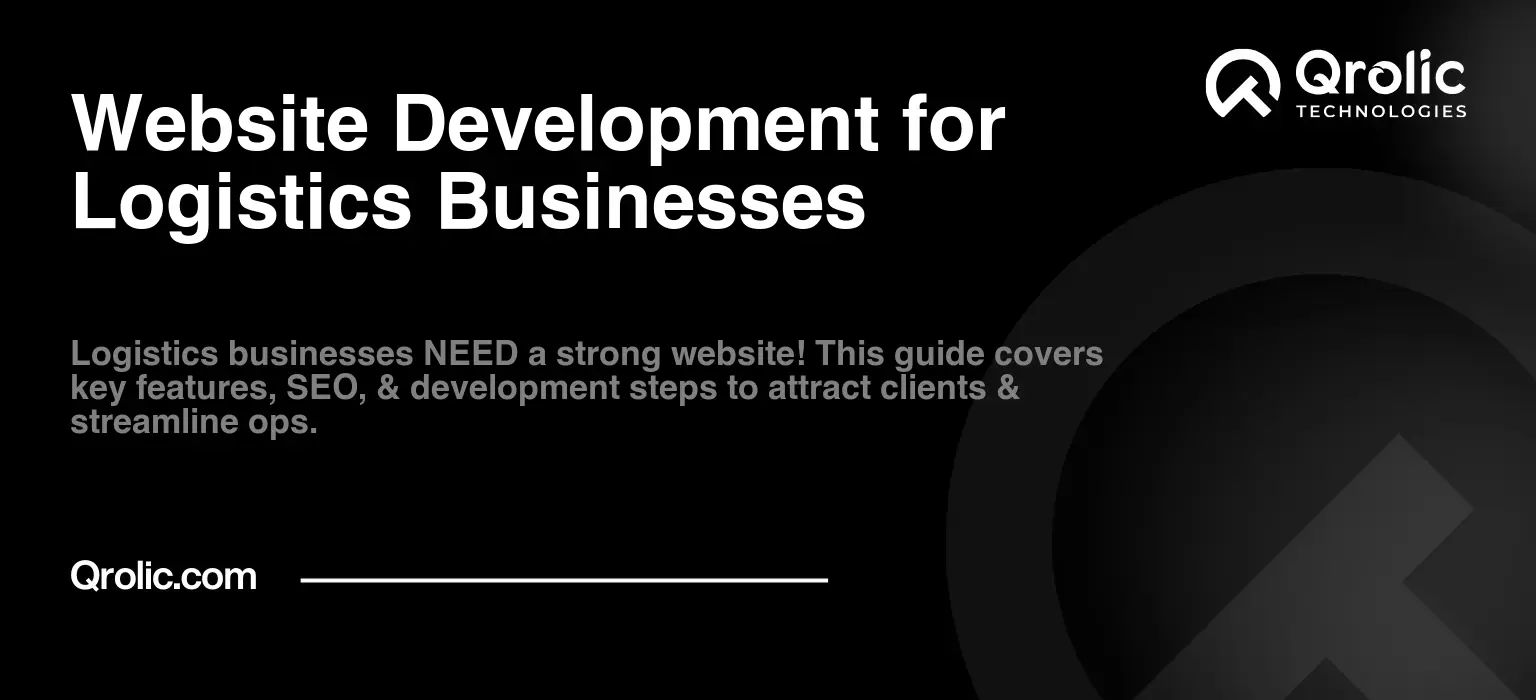In today’s fast-paced, digitally driven world, a robust online presence is no longer optional for logistics businesses – it’s absolutely essential. A well-designed website acts as a central hub for your operations, connecting you with clients, streamlining processes, and ultimately driving growth. But simply having a website isn’t enough. It needs to be tailored specifically to the unique demands and complexities of the logistics industry. This comprehensive guide explores everything you need to know about website development for logistics businesses, ensuring your online presence is optimized for success.
Quick Summary:
- A strong website is vital for logistics visibility and growth.
- Include real-time tracking, quote forms, and customer portals.
- Optimize your site with SEO and ensure mobile-friendliness.
- Choose a development partner with logistics industry experience.
Table of Contents
- Why Your Logistics Business Needs a Stellar Website
- Key Features of a Logistics Website
- Essential Steps in Logistics Website Development
- 1. Planning and Strategy
- 2. Design and Development
- 3. Launch and Promotion
- 4. Maintenance and Updates
- Optimizing Your Logistics Website for Search Engines (SEO)
- Common Mistakes to Avoid in Logistics Website Development
- Choosing the Right Website Development Partner
- Future Trends in Logistics Website Development
- Qrolic Technologies: Your Partner in Logistics Website Development
- Conclusion
Why Your Logistics Business Needs a Stellar Website
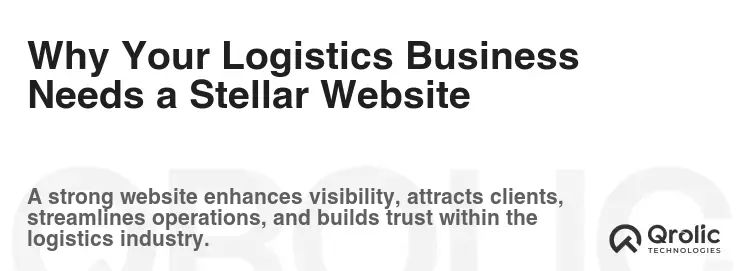
Think of your website as the digital face of your logistics operation. It’s often the first point of contact for potential clients, and it needs to make a strong, lasting impression. Here’s why a stellar website is crucial for your business:
-
Increased Visibility and Reach: In a competitive market, a website significantly expands your visibility. Search engines like Google can connect you with clients actively searching for logistics services, both locally and globally. This increased reach translates to more opportunities and greater market penetration. Think of it as casting a wider net to catch more customers.
-
Enhanced Credibility and Trust: A professional, well-maintained website instantly boosts your credibility. It demonstrates that you’re a serious, established player in the industry, giving potential clients confidence in your services. Details like client testimonials, security certifications, and industry awards further enhance trust. Would you entrust your valuable cargo to a company with a poorly designed or outdated website? Probably not.
-
Streamlined Communication and Customer Service: A website can automate many aspects of customer service. FAQs, contact forms, and live chat features can handle common inquiries, freeing up your team to focus on more complex tasks. Customers can easily track shipments, request quotes, and access important information, leading to increased satisfaction and loyalty. It’s like having a 24/7 customer service representative working for you.
-
Lead Generation and Business Growth: Your website is a powerful lead generation tool. By incorporating strategic calls to action, contact forms, and valuable content, you can attract potential clients and convert them into paying customers. A well-optimized website acts as a sales funnel, guiding visitors through the process and encouraging them to take the next step. Think of it as a magnet attracting new business opportunities.
-
Competitive Advantage: In a crowded market, a superior website can give you a significant competitive edge. A website that is user-friendly, informative, and visually appealing will stand out from the competition and attract more clients. It shows that you’re investing in your business and are committed to providing the best possible service.
-
Data Collection and Analytics: Your website provides valuable data about your customers, their behavior, and their needs. By tracking website traffic, engagement metrics, and conversion rates, you can gain insights into what’s working and what’s not. This data can be used to optimize your website, improve your marketing efforts, and make better business decisions. It’s like having a crystal ball that helps you predict the future.
Key Features of a Logistics Website
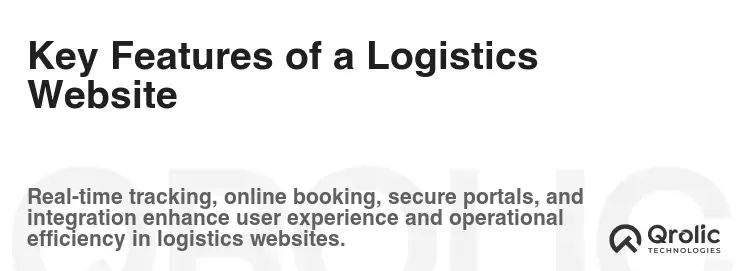
A successful logistics website goes beyond basic information. It needs to incorporate specific features that address the unique needs of the industry and your target audience.
-
Real-Time Tracking: This is arguably the most crucial feature. Clients need to be able to track their shipments in real-time, 24/7. Integrate with your tracking system to provide up-to-date information on location, status, and estimated delivery time. A visual map display can further enhance the user experience.
-
Quote Request Form: Make it easy for potential clients to request quotes for your services. The form should be comprehensive, capturing all the necessary information such as origin, destination, dimensions, weight, and special handling requirements. An automated quote generation system can further streamline the process.
-
Service Descriptions: Clearly outline the different services you offer, such as freight forwarding, warehousing, customs brokerage, and distribution. Provide detailed descriptions of each service, highlighting the benefits and value you provide. Use high-quality images and videos to showcase your capabilities.
-
Customer Portal: A secure customer portal allows clients to manage their accounts, view past shipments, download documents, and communicate with your team. This improves efficiency, reduces administrative overhead, and enhances customer satisfaction.
-
FAQ Section: Address common questions and concerns about your services. This saves time for your customer service team and provides valuable information to potential clients. Categorize the FAQs for easy navigation.
-
Blog and Resource Center: Share valuable content related to the logistics industry, such as industry news, regulatory updates, best practices, and tips for optimizing supply chains. This establishes you as a thought leader and attracts potential clients to your website.
-
Testimonials and Case Studies: Showcase positive feedback from satisfied clients. Testimonials build trust and credibility, while case studies demonstrate your ability to solve complex logistics challenges. Use video testimonials for an even greater impact.
-
Contact Information and Location Map: Make it easy for clients to contact you. Provide multiple contact options, such as phone number, email address, and contact form. Include a location map to help clients find your physical offices or warehouses.
-
Mobile Responsiveness: Ensure your website is fully responsive and optimized for mobile devices. Many clients will access your website from their smartphones or tablets, so a mobile-friendly design is essential.
-
Security: Implement robust security measures to protect sensitive client data. Use SSL encryption, regularly update your software, and implement security protocols to prevent hacking and data breaches.
Essential Steps in Logistics Website Development
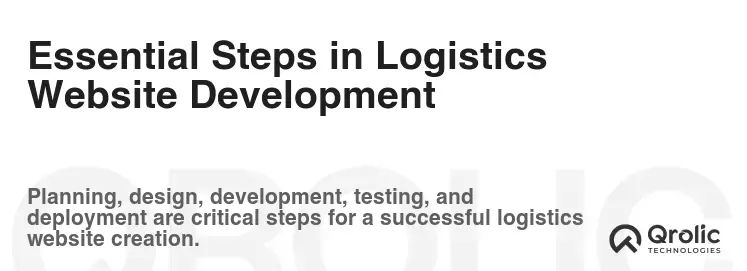
Developing a successful logistics website involves a structured process, from initial planning to ongoing maintenance.
1. Planning and Strategy
-
Define Your Goals: What do you want to achieve with your website? Increase leads, improve customer service, or enhance your brand image? Clearly define your goals and objectives before you start the design process.
-
Identify Your Target Audience: Who are you trying to reach with your website? Shippers, manufacturers, retailers, or other logistics providers? Understand your target audience’s needs and preferences, and tailor your website to meet them.
-
Conduct Competitive Analysis: Research your competitors’ websites to see what they’re doing well and what they’re not. Identify opportunities to differentiate yourself and offer something unique.
-
Develop a Content Strategy: Plan the content for your website, including service descriptions, blog posts, case studies, and FAQs. Create a content calendar to ensure a steady stream of fresh, engaging content.
-
Choose a Domain Name: Select a domain name that is relevant to your business, easy to remember, and reflects your brand identity.
-
Select a Hosting Provider: Choose a reliable hosting provider that can handle your website’s traffic and data storage needs. Consider factors such as uptime, security, and customer support.
2. Design and Development
-
Choose a Website Platform: Select a website platform that is suitable for your needs, such as WordPress, Drupal, or a custom-built solution. Consider factors such as ease of use, flexibility, and scalability.
-
Create a Website Design: Work with a web designer to create a visually appealing and user-friendly website design. The design should be consistent with your brand identity and reflect the professionalism of your business.
-
Develop Website Content: Write clear, concise, and informative content for your website. Use keywords strategically to improve your search engine ranking.
-
Implement Key Features: Incorporate the key features discussed earlier, such as real-time tracking, quote request form, and customer portal.
-
Test Your Website: Thoroughly test your website on different devices and browsers to ensure it is functioning properly. Fix any bugs or errors before launching your website.
3. Launch and Promotion
-
Launch Your Website: Once you are satisfied with your website, launch it to the public.
-
Promote Your Website: Promote your website through various marketing channels, such as search engine optimization (SEO), social media marketing, email marketing, and online advertising.
-
Monitor Website Performance: Track your website’s traffic, engagement metrics, and conversion rates. Use this data to optimize your website and improve your marketing efforts.
4. Maintenance and Updates
-
Regularly Update Your Website: Keep your website up-to-date with fresh content, security updates, and software upgrades.
-
Monitor Security: Regularly monitor your website for security vulnerabilities and take steps to mitigate them.
-
Back Up Your Website: Regularly back up your website to protect against data loss.
-
Respond to Customer Feedback: Actively solicit feedback from your customers and use it to improve your website and your services.
Optimizing Your Logistics Website for Search Engines (SEO)
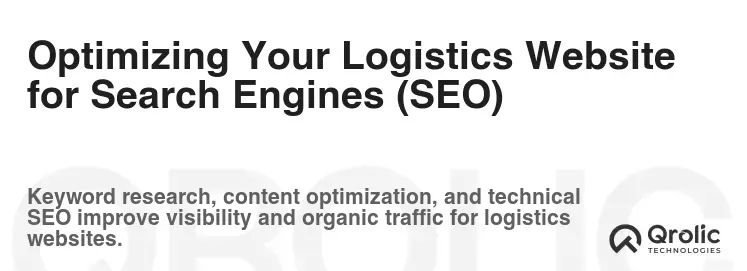
Search engine optimization (SEO) is crucial for driving traffic to your website and attracting potential clients. Here are some key SEO strategies to implement:
-
Keyword Research: Identify the keywords that your target audience is using to search for logistics services. Use keyword research tools such as Google Keyword Planner, SEMrush, and Ahrefs. Focus on keywords that are relevant to your business, have high search volume, and low competition.
-
On-Page Optimization: Optimize your website’s content, title tags, meta descriptions, and image alt tags with relevant keywords. Ensure your website is structured in a way that is easy for search engines to crawl and index.
-
Off-Page Optimization: Build high-quality backlinks from other websites. Backlinks are links from other websites to your website. They are a signal to search engines that your website is trustworthy and authoritative. You can build backlinks by creating valuable content, participating in industry forums, and reaching out to other website owners.
-
Technical SEO: Ensure your website is technically sound and optimized for search engines. This includes ensuring your website is mobile-friendly, has a fast loading speed, and is free of errors.
-
Local SEO: Optimize your website for local search. This includes creating a Google My Business listing, claiming your business on online directories, and building local citations.
-
Content Marketing: Create valuable and engaging content that attracts potential clients and establishes you as a thought leader in the industry. This includes blog posts, articles, case studies, infographics, and videos.
Common Mistakes to Avoid in Logistics Website Development
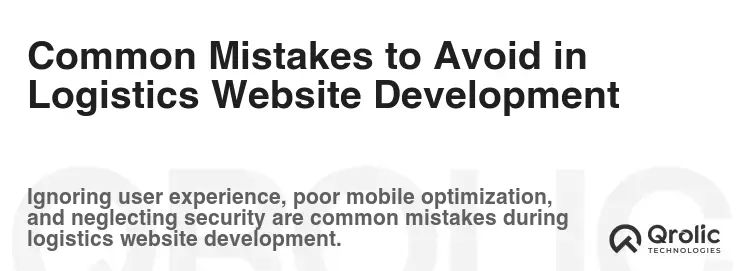
Avoid these common pitfalls to ensure your website is effective and successful:
-
Poor User Experience: A website that is difficult to navigate, slow to load, or visually unappealing will frustrate visitors and drive them away. Focus on creating a user-friendly experience that is intuitive and enjoyable.
-
Lack of Mobile Optimization: In today’s mobile-first world, a website that is not optimized for mobile devices will be penalized by search engines and will provide a poor experience for mobile users.
-
Ignoring SEO: Failing to optimize your website for search engines will make it difficult for potential clients to find you online. Invest in SEO to improve your search engine ranking and drive traffic to your website.
-
Neglecting Content: A website that is lacking in valuable and engaging content will fail to attract and retain visitors. Create high-quality content that provides value to your target audience.
-
Poor Security: A website that is not secure is vulnerable to hacking and data breaches. Implement robust security measures to protect sensitive client data.
-
Not Tracking Analytics: Failing to track your website’s performance will make it difficult to identify areas for improvement. Use analytics tools to monitor your website’s traffic, engagement metrics, and conversion rates.
Choosing the Right Website Development Partner
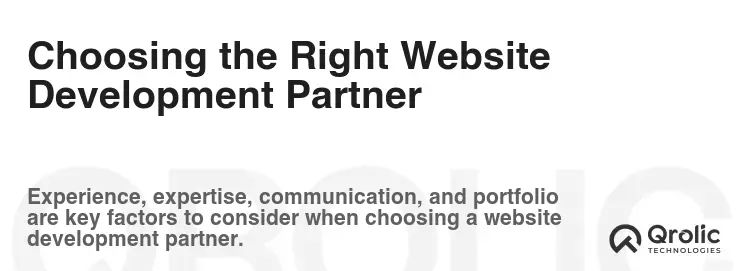
Selecting the right website development partner is crucial for the success of your project. Here are some factors to consider:
-
Experience: Choose a partner with experience in developing websites for the logistics industry. They should understand the unique needs and challenges of the industry.
-
Portfolio: Review their portfolio to see examples of their past work. Do their designs align with your brand identity and vision?
-
Technical Expertise: Ensure they have the technical expertise to implement the features you need, such as real-time tracking, quote request form, and customer portal.
-
Communication: Choose a partner who communicates clearly and responsively. They should be willing to listen to your needs and provide regular updates on the progress of your project.
-
Pricing: Get quotes from multiple partners and compare their pricing. Be sure to understand what is included in the price and what is not.
-
Support: Choose a partner who provides ongoing support and maintenance after the website is launched.
Future Trends in Logistics Website Development
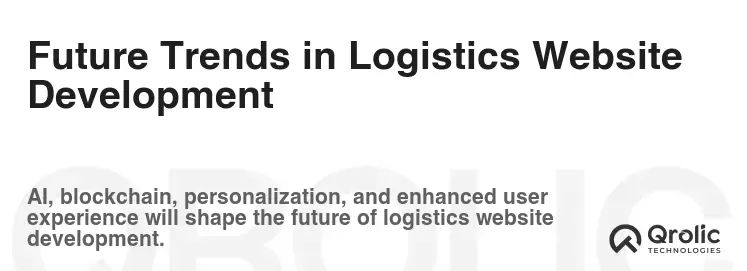
The logistics industry is constantly evolving, and website development trends are evolving along with it. Here are some future trends to keep in mind:
-
Artificial Intelligence (AI): AI is being used to automate various tasks, such as customer service, data analysis, and route optimization. AI-powered chatbots can provide instant support to customers, while AI algorithms can analyze data to identify trends and predict demand.
-
Blockchain Technology: Blockchain is being used to improve transparency and security in the supply chain. Blockchain-based platforms can track shipments in real-time, verify the authenticity of goods, and automate payments.
-
Internet of Things (IoT): IoT devices are being used to track assets, monitor conditions, and optimize operations. IoT sensors can track the location of goods, monitor temperature and humidity, and detect potential problems.
-
Augmented Reality (AR): AR is being used to enhance the customer experience. AR apps can allow customers to visualize products in their own environment, track shipments in real-time, and access product information.
-
Personalization: Websites are becoming increasingly personalized, tailoring the content and experience to each individual user. This includes personalized recommendations, targeted offers, and customized dashboards.
Qrolic Technologies: Your Partner in Logistics Website Development
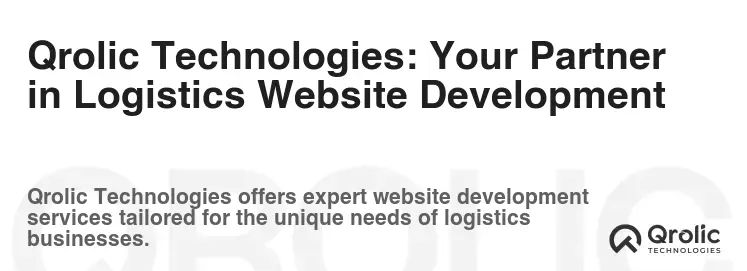
At Qrolic Technologies (https://qrolic.com/), we understand the unique challenges and opportunities of the logistics industry. We specialize in developing custom websites and software solutions that help logistics businesses streamline operations, improve customer service, and drive growth.
Why Choose Qrolic Technologies?
-
Industry Expertise: We have a deep understanding of the logistics industry and its specific needs.
-
Custom Solutions: We develop custom solutions tailored to your unique business requirements.
-
Proven Track Record: We have a proven track record of delivering successful website and software projects for logistics businesses.
-
Experienced Team: Our team of experienced designers, developers, and project managers is dedicated to providing the best possible service.
-
Ongoing Support: We provide ongoing support and maintenance to ensure your website and software are always running smoothly.
Our Services:
-
Website Design and Development: We design and develop custom websites that are visually appealing, user-friendly, and optimized for search engines.
-
E-commerce Development: We develop e-commerce solutions that allow you to sell your logistics services online.
-
Mobile App Development: We develop mobile apps that allow your customers to track shipments, request quotes, and manage their accounts.
-
Software Development: We develop custom software solutions that automate your business processes and improve efficiency.
-
SEO and Digital Marketing: We provide SEO and digital marketing services to help you attract more traffic to your website and generate more leads.
Let Qrolic Technologies help you build a website that drives your logistics business forward. Contact us today for a free consultation.
Conclusion
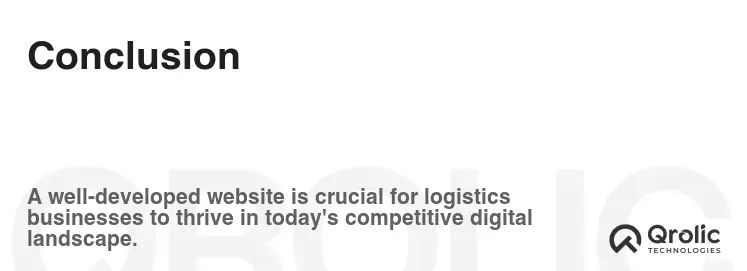
In conclusion, a well-designed and strategically developed website is an indispensable asset for any logistics business seeking to thrive in today’s competitive landscape. By prioritizing key features like real-time tracking, quote request forms, and customer portals, and by adhering to SEO best practices, you can create a powerful online presence that attracts new clients, streamlines operations, and fosters lasting customer relationships. Remember to avoid common mistakes, choose the right development partner, and stay abreast of future trends to ensure your website remains effective and relevant. Invest in your website, and you’ll invest in the future of your logistics business. A robust online presence is no longer a luxury; it’s a necessity for success in the modern logistics industry.
